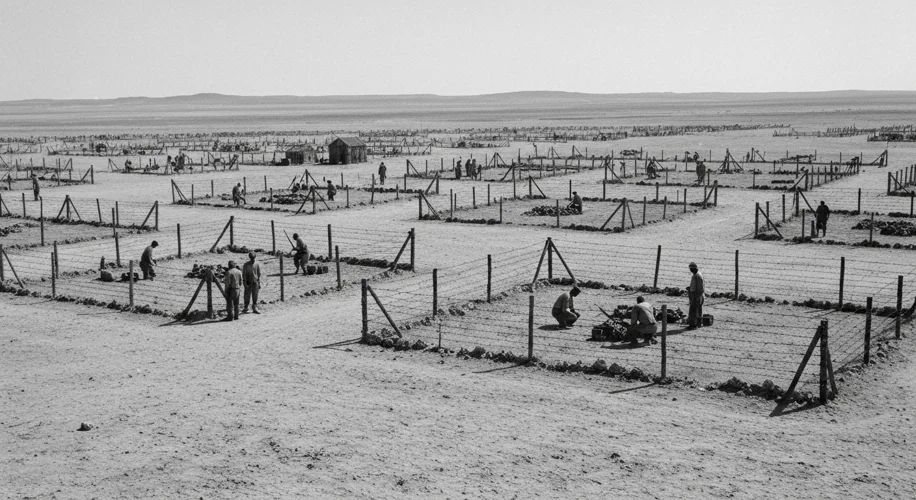The year is 1942. The cinematic world is abuzz with the release of Casablanca, a film that would become an enduring testament to wartime romance and sacrifice. Yet, amidst the smoky backrooms of Rick’s Café Américain and the desperate pleas for transit papers, a word cast a long shadow, a term that, for many, held a far more ambiguous and less terrifying meaning than it would decades later: ‘concentration camp’.
Today, the phrase conjures images of unimaginable horror, of systematic extermination and unspeakable suffering. But in 1942, as the world grappled with the unfolding global conflict, the public understanding of ‘concentration camp’ was still being shaped, largely by events in the Spanish Civil War and the early years of Nazi Germany.
A Continent Under Siege: The Pre-War Landscape
Before Casablanca hit the silver screen, the term ‘concentration camp’ had already appeared in global discourse. The Spanish Civil War (1936-1939) saw the Nationalist forces under Francisco Franco establish camps where political opponents and suspected sympathizers of the Republican cause were detained. These camps, while certainly places of hardship, internment, and often brutal conditions, were primarily characterized by forced labor, disease, and a lack of adequate provisions. News reports and accounts from survivors painted a grim picture, but the scale and industrialized nature of the later Nazi extermination camps were not yet widely understood.

Similarly, as early as 1933, the Nazis began establishing concentration camps within Germany, such as Dachau. Initially, these camps were used to detain political adversaries—communists, socialists, and trade unionists. The purpose was clear: to isolate and suppress opposition to the nascent Nazi regime. Prisoners endured harsh labor, public humiliation, and violence. However, the primary stated aim was re-education and punishment, not the systematic annihilation of entire populations based on their identity.
The ‘Refugee’ and the ‘Enemy Alien’ in Casablanca
In the world of Casablanca, the ‘concentration camp’ is alluded to through the looming threat of the Vichy French authorities and the Nazi regime. The desperate refugees seeking to escape Casablanca are primarily fleeing political persecution, war, and the collapse of freedoms. They are not, for the most part, explicitly aware that they are on the brink of a genocidal program targeting their ethnicity. The film’s narrative focuses on the immediate dangers of capture, imprisonment, and the loss of freedom, which were tangible threats associated with internment.
The film’s portrayal reflects the common understanding of the time. ‘Concentration camp’ could refer to a place where prisoners of war were held, where political dissidents were interned, or where ‘undesirables’ were subjected to forced labor and harsh conditions. It carried the weight of repression and the fear of a powerful, oppressive state, but the specific, chilling blueprint of the extermination camp had not yet been fully revealed to the world.
The Fog of War and Information
It’s crucial to remember the context of wartime information control. While reports of atrocities were beginning to filter out of occupied Europe, they were often fragmented, unconfirmed, or deliberately downplayed by propaganda machines on all sides. The full scope of the Holocaust, including the establishment of death camps like Auschwitz-Birkenau, Treblinka, and Sobibor, and the systematic, industrialized murder of millions of Jews, Roma, Sinti, homosexuals, and other targeted groups, was still largely hidden. The Allies themselves were often hesitant to publicize the most extreme reports, fearing they would be dismissed as propaganda or incite panic.
In 1942, the term ‘concentration camp’ was a vessel into which various horrors could be poured, but the specific, meticulously organized machinery of death was not yet the dominant association for most ordinary people. The immediate threat of imprisonment, forced labor, and potential mistreatment was the more prevalent public perception.
A Shifting Understanding
The release of Casablanca predates the liberation of the concentration camps and the full revelation of the Holocaust’s scale. As the war progressed, and particularly after 1944-1945, the true nature of the Nazi extermination camps became undeniable. Survivors’ testimonies, Allied liberation footage, and captured Nazi documents painted a horrifyingly clear picture of systematic murder.
The term ‘concentration camp’ thus underwent a profound and tragic evolution. What in 1942 might have evoked images of Franco’s internment camps or early Nazi labor facilities, by 1945, and certainly by the post-war Nuremberg Trials, became inextricably linked with the Holocaust. The word itself became a shorthand for the ultimate depravity of the Nazi regime, a symbol of genocide and the systematic dehumanization of millions.
Casablanca, in its brilliance, captured the atmosphere of a world teetering on the brink, where freedom was a precious, fragile commodity. And while the film’s characters navigated the immediate dangers of war and oppression, the full, devastating meaning of ‘concentration camp’ was a horror yet to be fully understood by the world watching.

